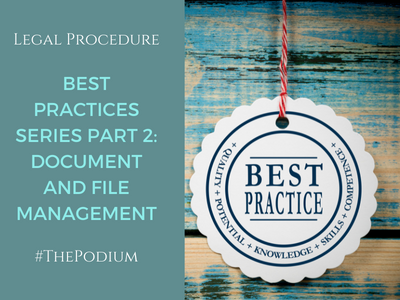
The first thing we have to do is stop reinventing the wheel and start implementing some of the most important document management best practices. In this article, you’ll learn how to implement ten essential practices that will make your day-to-day job easier than ever before.
- Set up a clear strategy
As the use of documents has grown, so have the opportunities for document management. When you create a document or file, it is not just sent to one person anymore; it may go across multiple people and departments. This means that it is useful to understand how documents are created, who creates them, and when they are created.
A document management strategy specifies how business documents should be created or received, organized, maintained, approved or rejected, stored, distributed, and destroyed in both electronic and paper formats. It should precisely describe these activities and be widely used in all departments. For a helpful description of document management strategies, check out: https://theecmconsultant.com/document-management-strategy/
- Manage documents in a single location
Documents are synonymous with productivity. However, as a business, it’s important to keep up with the trend in document management. Documents should be stored where they can be easily accessible and controlled by the owner. With cloud storage, documents can be securely stored in a single location so there is no need to worry about your files being copied or deleted by accident while they are in storage.
- Keep a record of documents
You should always save copies of your documents on your computer. You should also have backups of your documents on an external hard drive or another storage device in case you ever need to recover them.
Document retention and backup are crucial for every company. Most people save their work on their computer, but that’s not a reliable method of retaining documents in case disaster strikes or you need to be able to recover them. There are many storage alternatives available such as hard drives, external hard drives, cloud storage services and physically storing your documents on a USB drive.
- Keep only the documents you need
Document filing can be a bother. When you need to keep things, it can be hard to decide on what to keep and what to throw away. It’s important that you know how many documents you need and where they are stored. This will make it much easier for you when the time comes for a major clean-up or purging of files.
- Use a filing cabinet
We all know that one of the most important document management best practices is to use a filing cabinet to keep your documents organized. The bottom drawer of your filing cabinet should be used for incoming paperwork and the top drawer should be used for outgoing paperwork. Additionally, you can create folders on the right side of your filing cabinet that contains sub-folders.
- Consistent naming of documents
It is surprisingly easy for documents to get mislabeled when they are just stored in a folder on your computer or on a shared drive. This can lead to all kinds of issues, from an unreadable file that’s been renamed “Smith File” to missing content that has been renamed “Document1.” When you use the proper name for your files and folders, it’s easier to find what you need. Part of the strategy is to agree on consistent document naming conventions, especially for electronic files, in order to simply manage and find these documents in the future and to prevent documents from being overwritten.
- Define access control
Document access control is the process of verifying who has the right to see, modify, or delete a document in an organization. It is very important to clearly define a visual representation of which group can see which document types. A good practice is to create a sheet with document types as columns and groups as rows and filling this sheet in order to constantly maintain control over the security of your documents. As documents grow in volume, it becomes very easy to compromise security, putting critical information in danger of falling into the wrong hands.
- Take advantage of the Cloud
One of the best documentation management best practices is to migrate your data to the Cloud, which should bring tons of benefits. The Cloud is a powerful tool for managing documents. It is an online repository that can be accessed from any device, making it much easier to collaborate on projects.
Cloud storage enables users to share and collaborate on documents without having to worry about storing files in individual locations or sharing passwords. With cloud storage, there is no need to back up files or to worry about data loss. This simplifies the process of sharing and collaborating on documents.
- Master document version control
As the complexity of document filing grows, so does the need for document versioning. Automatic document tracking is handy to enable collaboration, decision-making, and enterprise-wide changes. For example, a company may have guidelines for how to apply for visas that are regularly updated. In this case, it would be useful to use automatic document tracking to create an audit trail of who is responsible for them and when they were updated. In addition to tracking changes in documents, automated document tracking can also track the movement of documents within a company.
- Invest in a document management system
Among the top documentation management best practices are adopting a DMS that will help your organization to manage and control all types of documents. A document management system is a collection of software that manages, tracks, and provides access to documents in a company or organization. They allow employees to collaborate with colleagues, share information and provide an overview of all the documents related to a certain project. This can be tremendously helpful for the organizational structure at work.
It is very important nowadays to invest in a good document management system to digitally manage your organization’s documents in the smoothest way possible while maintaining the proper security. There are many document management software that can help manage your organization’s documentation, your company files, and records. That is why it is very essential to take your time and choose the best document management system that suits your need.
Categorized in: Legal Procedure
| << previous | next >> |








